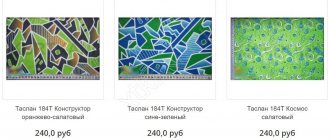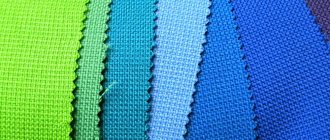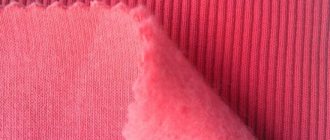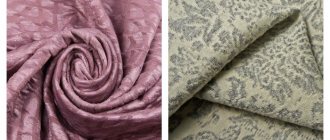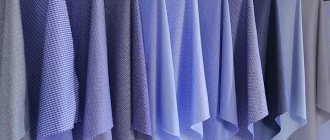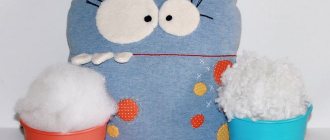Pique belongs to that category of fabrics that almost instantly attract a person’s gaze due to its original structure. This knitwear uses a special weave of threads, which provides a geometric pattern of the correct shape, made in a checkerboard pattern. The pique production technology is designed in such a way that even threads cannot be obtained. Various patterns of regular geometric shapes are one of the main features of pique. But this is only what can be immediately noticed even by a non-professional, since the fabric hides many more pleasant surprises in terms of practical characteristics.
History of creation
Such matter appeared back in the 20s of the last century and almost immediately became popular. It was especially actively used when sewing sportswear. Nowadays, almost any wardrobe item is made from pique: from light jackets to coats. This is due to the high level of quality and very practical characteristics of the fabric.
For the first time, they began to sew sportswear from pique thanks to the idea of the famous tennis player of that time, Rene Lacoste. Before that period, flannel was used to make most sportswear. But it was uncomfortable, often hindered movement and prevented me from feeling free.
For the first time, a pique shirt was demonstrated in public at a tournament with the participation of the same Lacoste. She made a great impression on the audience. After this incident, the fabric was often called lacoste, like the famous polo shirts, which are made from this material. Thus, do not confuse these concepts as if they are different fabrics, since they mean the same thing.
At the moment, although shirts are the most famous product, manufacturers also produce clothing for official events and uniforms made from this material.
Composition and method of production
The most pressing question among sportswear buyers is what pique fabric is made of. For the production of this material, exclusively cotton was used, which fits perfectly to the body. Nowadays pique is mixed with lycra, nylon or elastane to make sportswear for training.
You might be interested in What is technical felt: characteristics of a sheet building material
Note! This fabric stretches quite well. Therefore, such clothes can be worn when working out in the gym.
An equally popular query is “what is pique knitwear?” This type of fabric can be wool, half-woolen, silk, or viscose. That is, all types of fibers except cotton. The main composition of the product is cotton (at least 50%) and other fibers.
What is matter made of and how is it produced?
Basic properties
Pique fabric
The high level of demand for pique fabric is explained by its excellent quality characteristics, and not just the popularity of the manufacturer's brand. All the main advantages of complex weaving are embodied here. The material is made in a homogeneous structure, and on its surface a simple geometric pattern or simply an even ornament is made. A wide piece of fabric looks beautiful on its own, even without additional decorations. Pique holds its shape well and is practical, which made it popular in the sports field at one time. Simplicity and good preservation of appearance, colors and other parameters maintain the popularity of the material to this day.
Weaves in different types of fabric may differ from each other in density. This can be a loose structure, which well reflects all the qualities of standard knitwear. However, it does not embody all the advantages inherent in the base material that is used for the same shirts. In the loose type, the matter is stretched to the sides. If dense weaving is used, the material turns out to be very rigid and very different from the previous version.
Advantages
The advantages of pique include the following qualities:
- good crease resistance, which only increases when synthetic fibers are added to the material (but too many of them can lead to the loss of other beneficial properties);
- excellent wear resistance that lasts throughout the entire wearing period;
- the fabric is hygroscopic, so not only clothes, but also towels are made from it;
- good breathability ensures excellent air exchange and allows the skin to breathe normally under any conditions;
- the fabric does not require complex care, since piqué is an unpretentious material;
- hypoallergenic, making the material suitable for all people, even those with allergies;
- has antibacterial properties, which prevents the proliferation of microorganisms that can cause various diseases and allergies, including fungi and dust mites;
- environmentally friendly material.
Characteristics
Both experts and consumers note that pique fabric has many advantages over other fabrics.
- Provides free access of air to the body.
- Good hygroscopicity. The fabric perfectly absorbs moisture and dries quickly.
- Cotton material is 100% eco-friendly and hypoallergenic.
- Pique with the addition of synthetic fibers practically does not wrinkle and has good elasticity.
- Thanks to the dense weave of the threads in the structure, the fabric is highly durable, retains its original appearance for a long time and, with proper care, does not fade.
- The linen is pleasant to the body and keeps you warm, and summer clothes are absolutely not hot.
- Products made from this material do not require delicate care.
Another advantage is hygiene. Dust mites and mold do not grow in linen and clothes made from pique. A simple wash is enough to remove bacteria from the fabric.
Material composition
Polo Lacoste
In appearance, pique is a fairly dense textured knitwear with a complex structural weave. Common types of fabric have regular geometric patterns. In addition to these, there are even less common fabrics with an airy and loose structure.
The main difficulty of the production technology lies in creating a special weave. The fabric uses two cross and weft warp threads. As a result, it looks like quilting, but in fact, a different type of material creation is used here.
At the very beginning of production, companies made pique only from natural cotton without adding synthetics. But technology began to actively develop, after which synthetics began to appear in the composition. At the moment, the optimal cotton content is considered to be 50%. In budget fabric options, this figure can drop to 30%, but this also affects the quality of the material. This ratio leads to the fact that most benefits are simply canceled.
High-quality materials contain the following types of fibers:
- wool;
- cotton;
- viscose;
- wool mixture;
- nylon;
- silk.
If you add elastane to the fabric, or spandex as it is also called, the material will acquire additional plasticity. Pique with spandex is suitable for sewing tunics, blouses, bodycon dresses and other similar garments. It is hardly used in sportswear, but for more casual looks it works well.
This material is even found in the production of children's clothing. However, the fabrics used here are not those that are produced for sewing sportswear or outerwear. Here they make the so-called baby pique, where there is a small fleece on the wrong side. The main condition for using pique in sewing children's clothing is to contain as much natural cotton as possible in relation to other materials. Otherwise, using the fabric on sensitive baby skin will be unsafe.
History of the pike
Pique fabric was discovered in the 1920s and quickly became very popular and in demand. Initially it was used as sportswear. The discovery belongs to the famous tennis player Rene Lacoste. At that time, flannel was considered the most popular fabric for sewing sportswear. It was not a very comfortable material; it often hampered movement, which caused discomfort during active sports. The athlete did not feel free in products made from this fabric. There was a need for a lighter and more comfortable fabric for sports.
Rene Lacoste was the first to appear in public wearing a pique shirt at a tennis tournament. She had a luxurious appearance, fit perfectly and made a lasting impression on the audience. Thus, Lacoste left his mark on the history of pique development. Many athletes also paid attention to this material in order to purchase the same shirt for themselves. After this, piqué gains popularity, becomes very popular and is widely distributed throughout the world.
Over time, this fabric often began to be called lacoste, just like the famous polo shirt named after the famous Rene Lacoste - the first person to wear a shirt made of pique fabric. Currently, Lacoste is a world-famous fashion house for sewing polo shirts with crocs on the patch pocket, made from pique fabric. In addition, this brand produces various clothes, including bomber jackets, jackets, as well as bags and other accessories made from this fabric.
Over time, pique has become in great demand all over the world; it is a practical, lightweight and very comfortable material to wear. Many famous actors and musicians contributed to the development and popularity, they appeared on stage and in public wearing shirts, as well as polos and other clothing made from this fabric.
Pique today
Today, pique fabric is very popular and relevant. It comes in a variety of colors, so you can choose the perfect one to match your favorite style. High quality, environmental friendliness, as well as strength and wear resistance are considered the hallmark of this material. Modern pique fabric is used for the production of jackets, jackets, shirts, coats and accessories. Products made from this material are ideal for everyday life: going to work, school, meeting friends or on a date. The presentable appearance of pique products allows you to use clothes for various official and special occasions. In addition, pique is often used as a material for sewing uniforms. After many decades, this fabric has not lost its relevance, goes well with almost any style, is of high quality and is produced by the most famous clothing brands.
Product care
Washing practically does not damage the fabric, since the tight weave does not allow it to stretch. Also, no special care conditions are needed here. Almost all washing recommendations are similar to those given for ordinary knitwear. There are a minimum number of restrictions here.
The basic rules of care include the following points:
- pique can be washed in a regular washing machine using detergents, including synthetic ones;
- For tough types of fabrics, light starching after washing is recommended;
- The ironing mode must be determined by the label of a particular product, since for each of them different types of pique can be used with their own care characteristics;
- if there is a stain left on the clothes that cannot be washed in the usual way, then special stain removers can be used to remove it;
- drying can be either machine or ordinary, but if the product has a loose weave structure, then horizontal drying is recommended.
Based on the above points, as well as in comparison with other types of fabrics, pique looks very unpretentious. This is one of the factors that ensures high popularity for this jersey, and not only in the sports environment.
Care instructions
Pique does not require complex specialized care, so the recommendations are quite simple:
- Both hand and machine washing are allowed at a water temperature of 40 degrees C;
- Spin in the washing machine is allowed;
- tumble drying is allowed;
- When washing polo shirts, the manufacturer recommends gluing the corners of the collars with special stickers. This is necessary so that the corners of the collar do not bend;
- Items must be washed inside out; buttons must be fastened before placing in the washing machine;
- To preserve the shape and appearance of the product, you can lightly starch it after washing. The product is starched in this way: after washing, place it in hot water, having previously dissolved potato, corn or rice starch in it at the rate of 2 tablespoons per 3 liters of water. Then the product is carefully squeezed out and dried under natural conditions. Ironing must be done in a slightly damp state. You can also use ready-made solutions for starching - but you must strictly follow the recommendations on the packaging. There are also solutions for starching in aerosol packaging - just spray the product over the product.;
- The material must be ironed from the wrong side on the “cotton” setting (of course, if the composition is 100% cotton). Otherwise, carefully study the manufacturer's recommendations on the product label and follow them.
So, pique is a dense fabric with a relief pattern, easy to care for. Remarkably suitable for the production of summer clothing and home textiles.
© 2021 textiletrend.ru
How to choose quality pique products
Large selection of Lacoste polos
Based on the existence of several varieties of pique, there is no unambiguous quality standard here. Each type of clothing may require its own variety, with a softer or coarser texture. But in any case, the main indicator of quality is the composition of the material. The base should be made of natural cotton. Its content must be at least 50%. If there is more of it, the fabric will become softer. It may not hold its shape as well, but it breathes better and absorbs moisture.
The addition of nylon makes the fabric rougher, but significantly increases the practicality of use. This material lasts much longer and is very resistant to tearing. For those types of clothing that are subject to a lot of wear and tear, this can be a great option.
The amount of synthetic indicates how well the material holds its shape. It also makes caring for clothes easier, as it can easily withstand all washing and drying conditions. This is one of the most popular supplements used in peak. It also reduces the cost of the material. Interspersed with wool fibers make the fabric warmer.
Application of pique
The main area of application is sewing polo shirts. But these are far from the only things, and lately the range has grown significantly. Nowadays, formal shirts made from this fabric are very popular and are suitable for formal events. In many modern stores you can find the following clothing items:
- T-shirts;
- shirts;
- sports uniform;
- dresses;
- baby clothes;
- light bedspreads, including insulated ones;
- some types of outerwear in autumn and spring;
- decorative elements for clothing;
- towels, in particular waffle towels;
- cloth napkins;
- tablecloths;
- robes;
- pajamas;
- homewear;
- mattresses of varying degrees of hardness.
Kinds
Pique fabric comes in three types.
- Classic. This is a knitwear material that is used to make polo shirts. It has a structure of small cells - honeycombs, cells or rhombuses.
- Children's knitwear. Soft cotton material with a slight brushing.
- Bumazeya. The fabric has a characteristic relief structure, with a dense pile on the reverse side. It is mainly used in the production of warm underwear and tracksuits.
Interestingly, the familiar “waffle” towels are also made from pique fabric.
Types of fabric
Taking into account the fact that this fabric is very popular among buyers, many manufacturers are trying to introduce various modifications to it that create certain differences. Over the entire period of existence and development of production, several main varieties have been made. The main, so-called traditional varieties of pique include:
- Children's - here we use natural cotton fabric, the base of which is made thicker, and on the wrong side there is a light fleece. It is used both for sewing children's clothing and for light bedspreads. Some types of shirts and sportswear are also made from this variety. As a rule, it has the largest amount of cotton in its composition compared to the others.
- The French, or as it is also called “knitted” variety is considered the most common. It is this type of pique that is used for sewing polo shirts.
- Pique bumazea is a kind of improved version of the children's variety. In contrast, here a denser pile is used on the wrong side. It is used in the production of light outerwear, jackets and other items designed for warm periods.
In addition to variations in type of application and composition, there are also differences in weave density. This parameter also determines the feasibility of sewing a particular type of clothing from fabric. Additionally, the following types of fabric are distinguished:
- variegated;
- plain;
- unbleached.
Types of material
There are several types of fabric available on the market today. Among the wide range we can highlight:
- Knitted pique (French name) for making shirts called "Polo".
- Children's pique made of thick cotton fabric, lightly brushed. It is used exclusively for children's clothing.
- Pique paper is the wrong side of a densely brushed material. On the market you can find fabric: unbleached, plain, variegated.
What types of matter is divided into?
How to determine if you are really in a dive
There is a truly rich variety of fabrics on the market today, so some of them can easily be confused with real pique. To identify this variety, you should try to pull it. If after such manipulation the material returns to its original state, then it is a dive. In addition, a distinctive feature of the material is the presence of an original waffle pattern, which is due to the unique weaving of the material.
Pique knit fabric is an excellent choice when you want durable, long-lasting clothing with a high level of practicality. Improved strength characteristics here are achieved not just by new expensive materials, but by a unique type of weave. This is a complex weave of warp threads, which has proven its practical benefits for almost a hundred years and does not go out of fashion. The trademark Lacoste polo shirts have been and remain the hallmark of the fabric.


